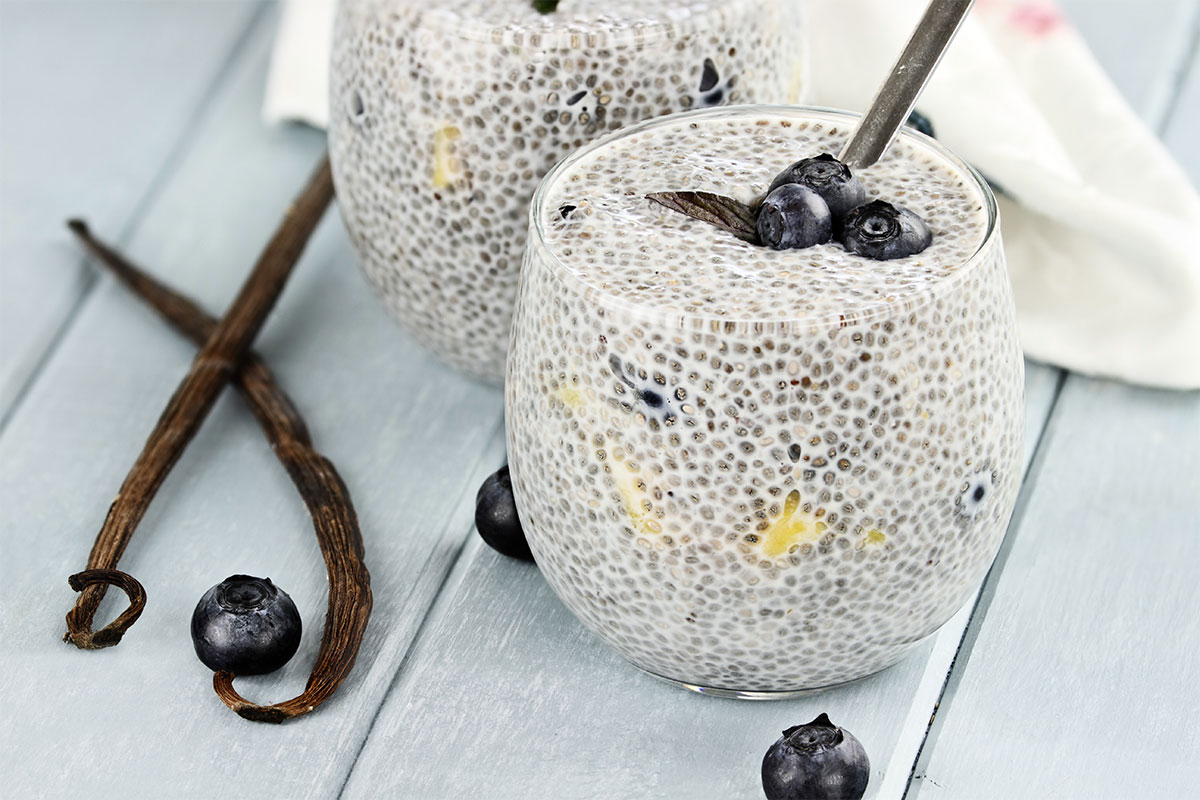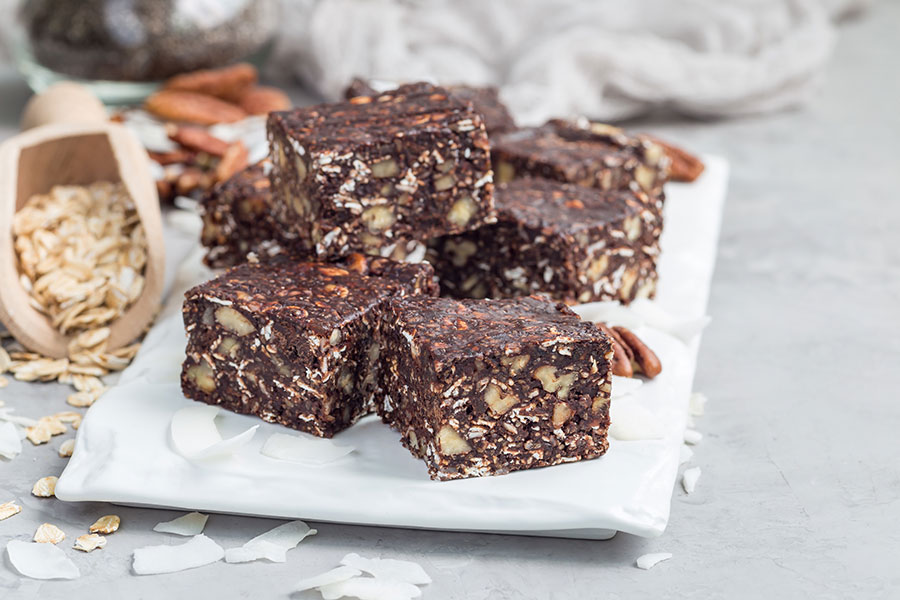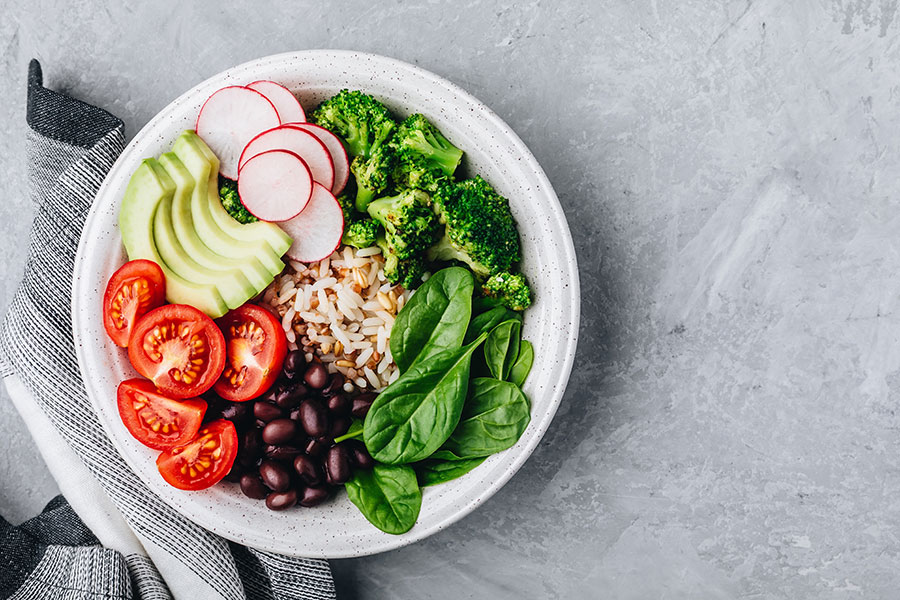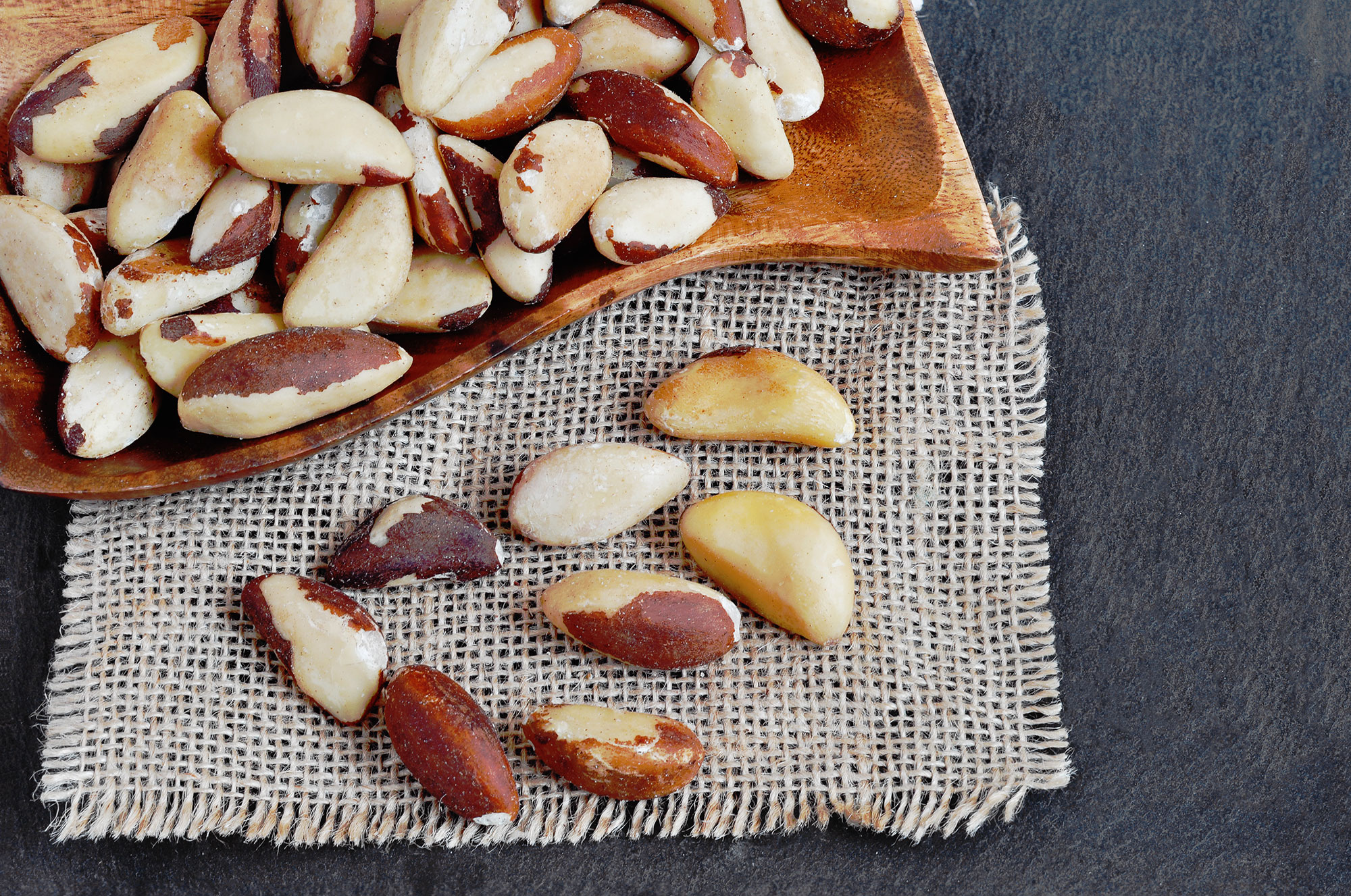8 Holiday Cookie Recipes That are Kind to Your Waistline
Counting calories during the holidays is tough! These healthier cookies are not, and they’ll please your palate without sabotaging your health goals.

Counting calories during the holidays may as well be a task for only the mightiest among us. The effort either requires enormous willpower or a serious dislike for holiday dishes. Aside from the calories, however, the holidays are often a time when cooking and baking together is part of the joy of the season.
That is why we’ve scoured the internet to compile a list of holiday cookie recipes that are more merciful on your waistline than their classic counterparts. You’ll find that it is possible to enjoy the tastes of the season without succumbing to the siren call of comfy sweatpants.

01.
Recipe #1 – Vegan Peanut Butter Protein Cookies
This recipe by Chocolate Covered Katie is a no-bake take on classic peanut butter cookies! This version tosses the flour and substitutes it with protein powder! The addition of applesauce is a surprising twist, but, including it in the cookie “dough” ensures your cookies are moist and still sweet despite the reduced sugar content.

02.
Recipe #2 – Paleo Chocolate Snowball Cookies
Nothing says December like cold weather and snow-capped mountains. So, a natural season favorite would have to be Snowball Cookies! Arman Liew shares his festive recipe on The Big Man’s World. With only 4 ingredients, and no baking involved, you can see why this recipe is hailed as a simple yet delicious treat. No kitchen savviness required.

03.
Recipe #3 – Flourless Tahini Cookies
If you’re unfamiliar with Tahini, it’s a sauce or paste made from toasted sesame seeds. On its own, it can be somewhat bitter, though some people will eat it by the spoonful as a cough suppressant. Does it work? We’re not sure, but does it make some great cookies? Yes, yes it does. Try out this recipe by Jyothi on The Curry Trail and let us know what you think of this nutty, low-fat cookie!

04.
Recipe #4 – Low Carb and Sugar Free “Oatmeal” Cookies
With sliced almonds stepping in for oats, these “oatmeal” cookies are a low carb alternative to the real thing. The only actual oat component is some oat fiber which is added to give these cookies their texture. Recipe creator, Kim Hardesty, suggests substituting this ingredient for coconut flour if you want to go completely oat free. Check out her instructions on Low Carb Maven.

05.
Recipe #5 – Healthy Gingerbread Cookies
The holidays are not complete without the spicy snap of gingerbread cookies. Easy to make, fun to decorate, and delicious to share, this seasonal favorite now comes in a healthier recipe. You won’t find a trace of refined flour or sugar, or any butter (if you choose coconut oil) in these wintertime treats. You’ll also get some tips on how to get that perfect gingerbread man shape. The details are all here, on Amy’s Healthy Baking website.

06.
Recipe #6 – Gluten Free Paleo Coconut Cookies
These Coconut Cookies are Paleo friendly, vegan, gluten-free, and even dairy-free. This recipe calls for only 4 ingredients, but the secret to this baked good is in the technique, not in any secret ingredients or special substitutions. Demeter breaks down her process in a detailed step by step guide on Beaming Baker. Take a look!

07.
Recipe #3 – Flourless Tahini Cookies
We had to include a recipe that plays on the classic oatmeal raisin cookie. Naturally sweetened with honey and made with nutritious ingredients like oats, flaxseed, pumpkin seeds, and cranberries, these energy-packed cookies deserve more time in the day than just breakfast. Regina’s popular recipe can be found on Leelalicious.

08.
Recipe #8 – Skinny Snickerdoodles
We close off our list with another recipe by Chocolate Covered Katie because making snickerdoodles healthy looks like a tough undertaking, and this recipe looks just right. With different options for your flour and sweetener, and only a quarter cup of butter, skinny snickerdoodles look like a great addition to our holiday cookie list. Fill your kitchen with the smells of warm cinnamon and watch everyone within sniffing distance come by to investigate.
It’s okay to indulge in a few healthier snacks this season, and of course, moderation is key. Some treats, like dark chocolate and almonds, even have some health benefits. To keep from over-indulging, read our registered dietitian’s Super Snacking Guide for ideas on how to keep your snacking on the healthy side. To access our monthly blog post highlights, subscribe to our newsletter today!


I want to follow a daily routine which will help me reduce weight. Currently, I am 129 lbs. I want to reduce it to 120 lbs; however, I am a vegetarian. I don’t eat eggs or meat. Please help.
– Swapna A.

Vegetarian diet or not, the same rules apply for reducing body fat to lose weight: eat less than you burn. Where vegetarians may have trouble is with concentrated sugars (in foods like smoothies, cereals, fruit bars) and excess fats (hidden oils in boxed/frozen foods). Restricting intake of processed foods while focusing on whole plant foods will ensure you control the amount of sugar and fat consumed. Basically, choose foods you need to chew!
Consider a healthy vegetarian dish of lentils, mushroom, onion, chopped spinach, olive oil and carrot over sweet potatoes. Despite the correct balance of carbohydrates, fats and protein you still need to deal with volume. Do you fill a 10-inch plate, 20 oz. bowl or only a cup? Portion control is important, no matter the diet you follow. Just cutting back 50 calories a day can promote a 5-pound weight loss over a year.
I wouldn’t advise a daily menu repeated over and over because you need a variety of produce, legumes, nuts and seeds to meet micronutrient requirements and provide beneficial phytochemicals. But, you can start with a few days mapped out for you! EatingWell® has a decent vegan 7 day 1200 calorie plan. For a week’s worth of lacto-ovo Indian meal suggestions, check out this traditional plan from Healthline. Also read the Living Healthy blog’s Ask Our Dietitian post How to Lose Fat as a Vegan for more meal and snack options.
– Debbie J., MS, RD
This article should not replace any exercise program or restrictions, any dietary supplements or restrictions, or any other medical recommendations from your primary care physician. Before starting any exercise program or diet, make sure it is approved by your doctor.
Some questions have been edited for length and/or clarity.
 Have a nutrition question? Our registered dietitian is ready to help!
Have a nutrition question? Our registered dietitian is ready to help!
Email nutrition@lafitness.com or submit your question below and it may be featured in an upcoming article!
Counting calories during the holidays is tough! These healthier cookies are not, and they’ll please your palate without sabotaging your health goals.
Think outside the breakfast box when it comes to morning meals with selective ingredients! You can adapt traditional breakfast foods by using these substitutes.
Check out our list of selected non-grain plant foods highest in methionine, given in common portions/(gram weight) with corresponding protein content.


My question is about breakfast for vegans. I’m avoiding carbs, grains, gluten. I don’t eat bread, pasta, grains. What would you recommend for breakfast?
– Siposs V.

Think outside the breakfast box when it comes to morning meals with selective ingredients! You can adapt traditional breakfast foods by substituting for the grains or transform meals otherwise considered for lunch/dinner.
Some tasty options for a vegan grain-free breakfast include:
– Debbie J., MS, RD






This article should not replace any exercise program or restrictions, any dietary supplements or restrictions, or any other medical recommendations from your primary care physician. Before starting any exercise program or diet, make sure it is approved by your doctor.
Some questions have been edited for length and/or clarity.
 Have a nutrition question? Our registered dietitian is ready to help!
Have a nutrition question? Our registered dietitian is ready to help!
Email nutrition@lafitness.com or submit your question below and it may be featured in an upcoming article!
Counting calories during the holidays is tough! These healthier cookies are not, and they’ll please your palate without sabotaging your health goals.
Think outside the breakfast box when it comes to morning meals with selective ingredients! You can adapt traditional breakfast foods by using these substitutes.
Check out our list of selected non-grain plant foods highest in methionine, given in common portions/(gram weight) with corresponding protein content.


What is a good alternative to grains as a way to complement the protein in legumes? Legumes are nutrient dense in many ways, including protein. But legume protein is low in methionine, an amino acid that our bodies cannot make. For this reason legumes have traditionally been combined with grains, which are high in methionine. Grains are low in another amino acid our bodies cannot make, lysine. Legumes are high in lysine. For this reason, legume and grain proteins are said to be complimentary. But if I am considering a long term dietary shift away from grains, I cannot be reassured by that. We still need to combine our proteins well over the course of several days. Unfortunately, grains are not a nutrient dense food. They are very high in starch and low in phytonutrients. So, what are some nutrient dense sources of methionine and cysteine? Or, in simpler terms, what is a good alternative to grains as a way to compliment legume protein?
– Benjamin H.

Vegan diets do tend to be low in methionine1, one of the essential amino acids. Interestingly enough, it’s actually proposed that a lower methionine intake is better for longevity1.
The World Health Organization recommends the adult dietary requirement is 10.4 mg of methionine per kg body weight per day to cover obligatory oxidative loses2. Whereas the US Recommended Dietary Allowances combine the methionine requirement with cysteine (a non-essential amino acid) for a total of 19 mg combined of methionine and cysteine/kg/day3. In plant foods, there are about equal amounts of methionine and cysteine.
“Wheat and rice proteins are comparatively low in lysine but better sources of methionine whereas beans and peas are relatively high in lysine yet in lower methionine.” — www.vegsoc.org/protein
Here are selected non-grain plant foods highest in methionine, given in common portions/(gram weight) with corresponding protein content4:
Brazil nuts, dried
Soybeans, boiled
Chia seeds, dried
White beans, canned
Sunflower seed kernels, dry roasted
Russet potato, baked w/ skin
Chickpeas/Garbanzo, canned
Peanuts, Spanish
Red potato, baked w/ skin
Spinach, cooked
Coconut milk, canned
Peaches, dried
Turnip greens, cooked from frozen
Corn kernels, cooked from frozen
Avocado, California
Spinach, boiled
Brown mushrooms, raw
Broccoli, cooked chopped
Raw seaweed spirulina
Asparagus, cooked
Zucchini
Cauliflower
Spinach, raw
373 mg in ¼ C (33g)
192 mg in ½ C (86g)
167 mg in 1 oz (28 g)
143 mg in ½ C (131g)
134 mg in ¼ C (32g)
123 mg in large 3-4” (299g)
118 mg in ½ C (127g)
117 mg in ¼ C (36g)
105 mg in large 3-4” (299g)
99 mg in 1 C (180g)
86 mg in 1 C (226g)
70 mg in ½ C (80g)
62 mg in ½ C (82g)
59 mg in ½ C (70g)
48 mg in 1 fruit (130g)
49 mg in ½ C (90g)
42mg in 1 C (87g)
34 mg in ½ C (78g)
33 mg in 1 oz (28 g)
31 mg in ½ C (90g)
18 mg in ½ C (116mg)
16 mg in ½ C (62g)
16 mg in 1 C (30g)
4.75 g protein
15.5 g protein
4.5 g protein
9.5 g protein
6 g protein
8 g protein
9 g protein
9.5 g protein
7 g protein
5 g protein
4.5 g protein
3 g protein
2.5 g protein
2.5 g protein
2.5 g protein
2.75 g protein
2 g protein
2 g protein
2 g protein
2 g protein
1 g protein
1 g protein
1 g protein
Our vegetarian audience may also be interested in a thorough discussion at http://www.veganhealth.org/articles/protein and some of our previous articles below for protein information.
References:
– Debbie J., MS, RD
This article should not replace any exercise program or restrictions, any dietary supplements or restrictions, or any other medical recommendations from your primary care physician. Before starting any exercise program or diet, make sure it is approved by your doctor.
Some questions have been edited for length and/or clarity.
 Have a nutrition question? Our registered dietitian is ready to help!
Have a nutrition question? Our registered dietitian is ready to help!
Email nutrition@lafitness.com or submit your question below and it may be featured in an upcoming article!
Counting calories during the holidays is tough! These healthier cookies are not, and they’ll please your palate without sabotaging your health goals.
Think outside the breakfast box when it comes to morning meals with selective ingredients! You can adapt traditional breakfast foods by using these substitutes.
Check out our list of selected non-grain plant foods highest in methionine, given in common portions/(gram weight) with corresponding protein content.


I am a vegan and was just wondering if you could give me some tips on my diet. I have been eating lots of beans, whole grains, fruits, and vegetables but I’ve noticed that I feel bloated. How many servings of proteins such as bean or lentils do you recommend daily? Are there any other sources of protein you recommend?
– Alyssa S

Many plant foods contain fermentable components that cause gas and bloating. These compounds are known as FODMAPs (fermentable oligosaccharides, disaccharides, monosaccharides and polyols) and certain sources have more than others. Since the list of foods high in FODMAPs is quite extensive, I’ve referenced it here. Following a diet low in FODMAPs is usually to treat gastrointestinal disorders and is best done under the supervision of a Registered Dietitian Nutritionist or gastroenterologist familiar with a low FODMAPs diet.
As you’re probably aware, fruit and fats/oils have negligible protein. Beans, lentils and peas are the best source of vegan protein (by weight) and two half-cup servings are recommended daily. Nearly complete amino acid profiles are found in soybeans and soy products. Since they aren’t high in methionine, you’ll need other legumes and grains to meet your methionine need. These should be eaten nearly every meal. To round out your amino acid profile with grains and beans, you should consume about an equivalent of 2 ounces of nuts daily, such as ¼ cup almonds or ½ C pumpkin seeds. This will help meet the remainder of your protein requirement.
– Debbie J., MS, RD



Want more? SUBSCRIBE to receive the latest Living Healthy articles right in your inbox!
This article should not replace any exercise program or restrictions, any dietary supplements or restrictions, or any other medical recommendations from your primary care physician. Before starting any exercise program or diet, make sure it is approved by your doctor.
Some questions have been edited for length and/or clarity.
 Have a nutrition question? Our registered dietitian is ready to help!
Have a nutrition question? Our registered dietitian is ready to help!
Email nutrition@lafitness.com or submit your question below and it may be featured in an upcoming article!
If you’re careful with your nutrition, working out weekly, and still experiencing problems with your weight, take a moment to read this QA.
Blood sugar control isn’t easy. These are Debbie’s top recommendations for how to address weight control with Type II Diabetes.
On this episode of ‘Ask A Trainer’ we speak with LA Fitness Pro Results® trainer Morgan C., and get her expert advice on whether or not strength training or cardio should come first when it comes to weight loss.
Be the first to know about exclusive
content, deals and promotions